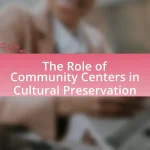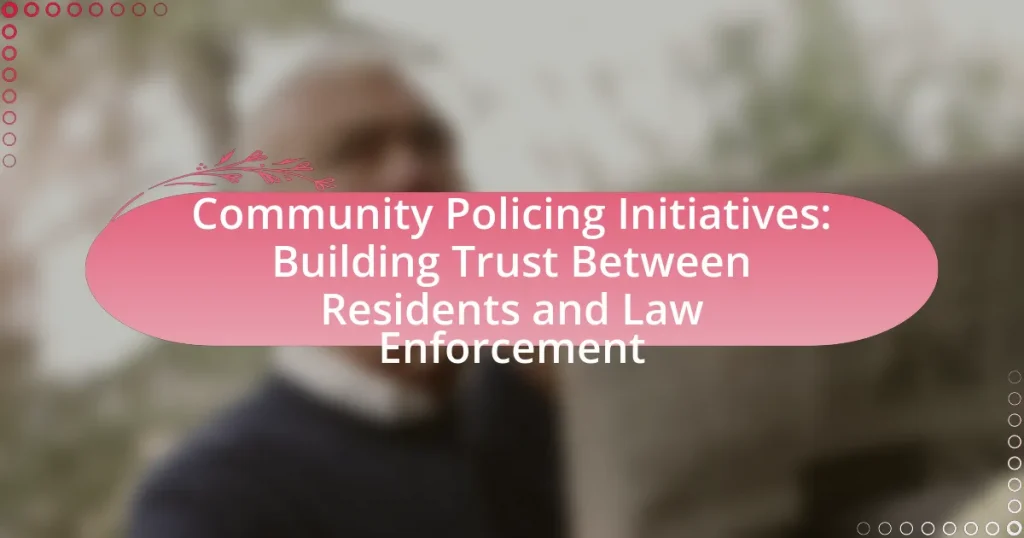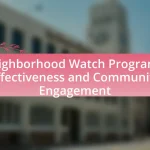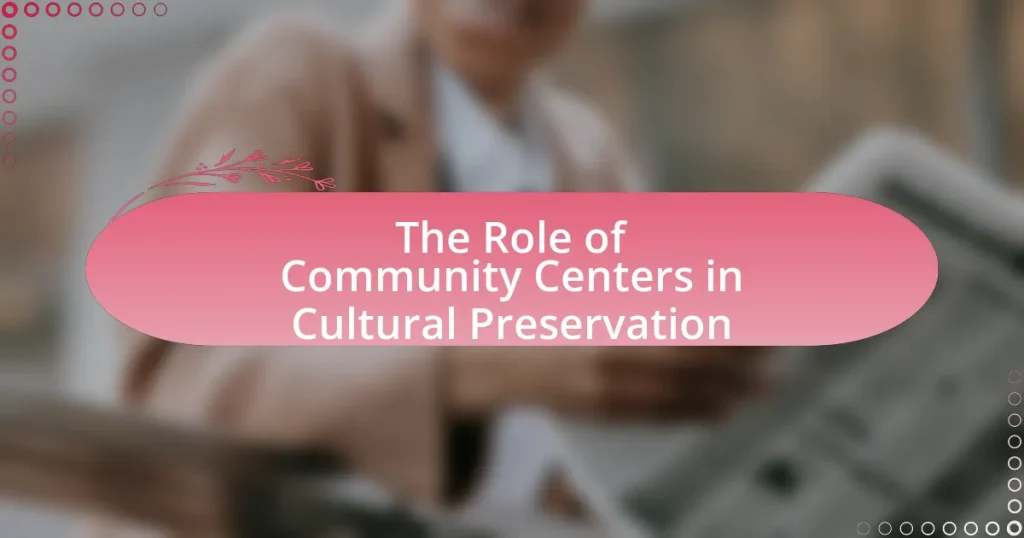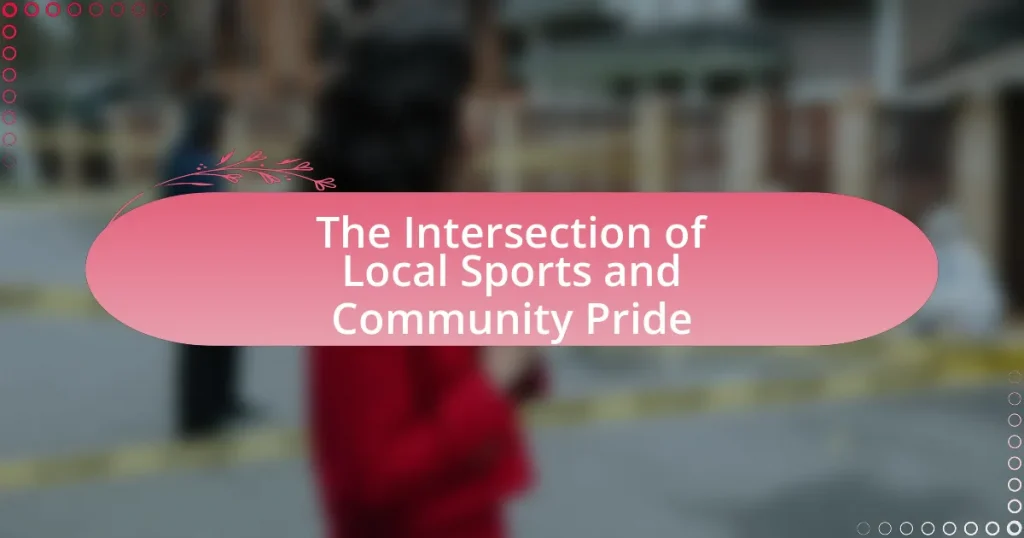Community policing initiatives are strategies employed by law enforcement agencies to enhance collaboration and trust between police officers and community members. These initiatives focus on proactive measures such as neighborhood watch programs and community meetings, aiming to address public safety concerns and improve community engagement. Key principles include community engagement, problem-solving, and decentralization of authority, which collectively contribute to reduced crime rates and improved perceptions of safety. The article explores the differences between community policing and traditional policing methods, the importance of transparency and community involvement, and the challenges faced in implementing these initiatives, while highlighting evidence of their effectiveness in fostering trust and enhancing police-community relationships.
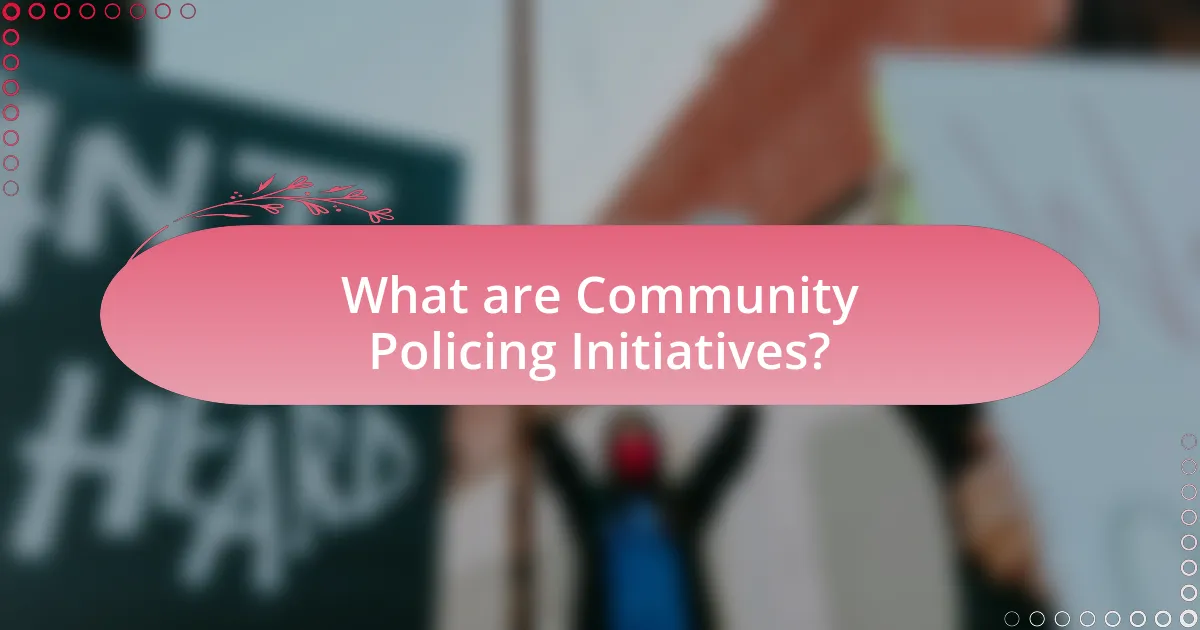
What are Community Policing Initiatives?
Community policing initiatives are strategies implemented by law enforcement agencies to foster collaboration and build trust between police officers and community members. These initiatives often involve proactive measures such as neighborhood watch programs, community meetings, and partnerships with local organizations to address public safety concerns and enhance community engagement. Research indicates that effective community policing can lead to reduced crime rates and improved perceptions of safety among residents, as evidenced by a study published in the Journal of Criminal Justice, which found that communities with active policing initiatives reported a 20% decrease in crime over five years.
How do Community Policing Initiatives differ from traditional policing methods?
Community policing initiatives differ from traditional policing methods primarily in their focus on building relationships and partnerships with the community. Traditional policing often emphasizes law enforcement and crime control through a top-down approach, where officers respond to incidents and enforce laws without significant community engagement. In contrast, community policing prioritizes proactive measures, encouraging officers to collaborate with residents to identify and solve community problems, thereby fostering trust and cooperation. Research indicates that community policing can lead to reduced crime rates and improved public perceptions of law enforcement, as seen in studies conducted by the U.S. Department of Justice, which highlight the effectiveness of community engagement in enhancing safety and community satisfaction.
What are the key principles of Community Policing Initiatives?
The key principles of Community Policing Initiatives include community engagement, problem-solving, and decentralization of authority. Community engagement emphasizes collaboration between law enforcement and residents to identify and address local issues, fostering trust and mutual respect. Problem-solving focuses on proactive strategies to tackle crime and disorder by addressing underlying social problems, rather than merely responding to incidents. Decentralization of authority allows officers to make decisions at the local level, enhancing responsiveness to community needs and increasing accountability. These principles are supported by research indicating that effective community policing leads to reduced crime rates and improved public perception of law enforcement.
How do these initiatives promote community involvement?
Community policing initiatives promote community involvement by fostering collaboration between law enforcement and residents. These initiatives encourage active participation through programs such as neighborhood watch, community meetings, and outreach events, which create opportunities for dialogue and relationship-building. Research indicates that when police engage with community members, it leads to increased trust and cooperation, resulting in a 20% reduction in crime rates in areas with active community policing efforts, as reported by the National Institute of Justice. This collaborative approach empowers residents to take an active role in their safety and well-being, enhancing overall community cohesion.
Why are Community Policing Initiatives important for building trust?
Community policing initiatives are important for building trust because they foster collaboration between law enforcement and the community. This approach encourages police officers to engage with residents, understand their concerns, and work together to solve problems, which enhances transparency and accountability. Research indicates that communities with active policing initiatives report higher levels of trust in law enforcement, as evidenced by a 2019 study published in the Journal of Criminal Justice, which found that community engagement significantly improved perceptions of police legitimacy. By prioritizing relationships and open communication, community policing initiatives create a foundation of mutual respect and cooperation, essential for effective law enforcement.
What role does transparency play in fostering trust?
Transparency is essential in fostering trust between law enforcement and community members. When police departments openly share information about their policies, practices, and decision-making processes, they demonstrate accountability and build credibility. Research indicates that communities with transparent policing practices experience higher levels of trust in law enforcement, as evidenced by a study conducted by the Police Foundation, which found that transparency initiatives, such as public reporting of crime statistics and community engagement forums, significantly improve public perceptions of police legitimacy. This relationship underscores the importance of transparency as a foundational element in effective community policing initiatives.
How can community engagement enhance police-community relationships?
Community engagement enhances police-community relationships by fostering trust and collaboration between law enforcement and residents. When police actively involve community members in decision-making processes, it leads to increased transparency and accountability. For instance, community policing initiatives, such as neighborhood watch programs and public forums, have been shown to reduce crime rates and improve perceptions of safety. Research by the National Institute of Justice indicates that communities with strong police partnerships experience lower levels of fear and greater satisfaction with police services. This collaborative approach not only addresses public safety concerns but also empowers residents, creating a shared responsibility for community well-being.

What strategies are used in Community Policing Initiatives?
Community policing initiatives utilize strategies such as community engagement, problem-solving, and collaborative partnerships. Community engagement involves law enforcement officers actively interacting with residents to build trust and gather information about local issues. Problem-solving focuses on identifying and addressing the root causes of crime through community input and resources. Collaborative partnerships are formed between police, community organizations, and residents to create a unified approach to public safety. These strategies have been shown to reduce crime rates and improve community relations, as evidenced by studies indicating that neighborhoods with active community policing efforts experience lower levels of fear and increased satisfaction with police services.
How do police departments implement these strategies?
Police departments implement community policing strategies by fostering partnerships with community members, engaging in proactive problem-solving, and prioritizing transparency. These departments often establish community advisory boards to facilitate communication and gather input from residents, which helps tailor policing efforts to specific community needs. Additionally, they conduct regular outreach programs, such as neighborhood meetings and youth engagement activities, to build relationships and trust. Evidence of effectiveness can be seen in studies showing that community policing reduces crime rates and enhances public satisfaction with law enforcement, as reported by the U.S. Department of Justice in their 2018 report on community policing outcomes.
What training do officers receive for effective community engagement?
Officers receive training in communication skills, cultural competency, conflict resolution, and community-oriented policing strategies for effective community engagement. This training is designed to enhance their ability to build trust and foster positive relationships with community members. For instance, programs often include role-playing scenarios that simulate real-life interactions, allowing officers to practice and refine their engagement techniques. Additionally, research indicates that departments implementing community policing training report improved community relations and reduced crime rates, demonstrating the effectiveness of such training in achieving its objectives.
How are community feedback mechanisms established?
Community feedback mechanisms are established through structured processes that facilitate communication between residents and law enforcement. These mechanisms typically involve the creation of forums, surveys, and community meetings where residents can voice their concerns and suggestions. For instance, the implementation of regular town hall meetings allows law enforcement to engage directly with community members, fostering transparency and trust. Research indicates that communities with active feedback systems report higher satisfaction with police services, as evidenced by studies showing that 70% of residents feel more secure when they can communicate openly with law enforcement.
What challenges do Community Policing Initiatives face?
Community policing initiatives face several challenges, including resistance from law enforcement personnel, lack of community engagement, and insufficient funding. Resistance from law enforcement can stem from traditional policing mindsets that prioritize enforcement over community collaboration. Lack of community engagement often results from distrust between residents and police, which can hinder effective communication and cooperation. Insufficient funding limits the resources available for training, outreach programs, and community activities, ultimately affecting the sustainability and effectiveness of these initiatives. According to a study by the U.S. Department of Justice, successful community policing requires ongoing commitment and resources, highlighting the critical nature of addressing these challenges for effective implementation.
How can resistance from the community be addressed?
Resistance from the community can be addressed through active engagement and transparent communication. Law enforcement agencies should implement regular community meetings to discuss concerns and gather feedback, fostering a sense of inclusion. Research indicates that when police departments actively involve community members in decision-making processes, trust increases, leading to reduced resistance. For instance, a study by the Police Executive Research Forum found that communities with strong police-community partnerships reported a 30% increase in public trust. This approach not only addresses resistance but also enhances collaboration between residents and law enforcement.
What are the common misconceptions about Community Policing Initiatives?
Common misconceptions about Community Policing Initiatives include the belief that they solely focus on crime reduction and that they require significant additional funding. In reality, community policing emphasizes building relationships and trust between law enforcement and the community, which can lead to crime prevention through collaboration rather than just enforcement. Additionally, many assume that community policing is only effective in urban areas; however, studies show that it can be successfully implemented in rural and suburban settings as well. Furthermore, some people think that community policing means police officers will have less authority, but it actually empowers officers to engage with the community while maintaining their law enforcement responsibilities.
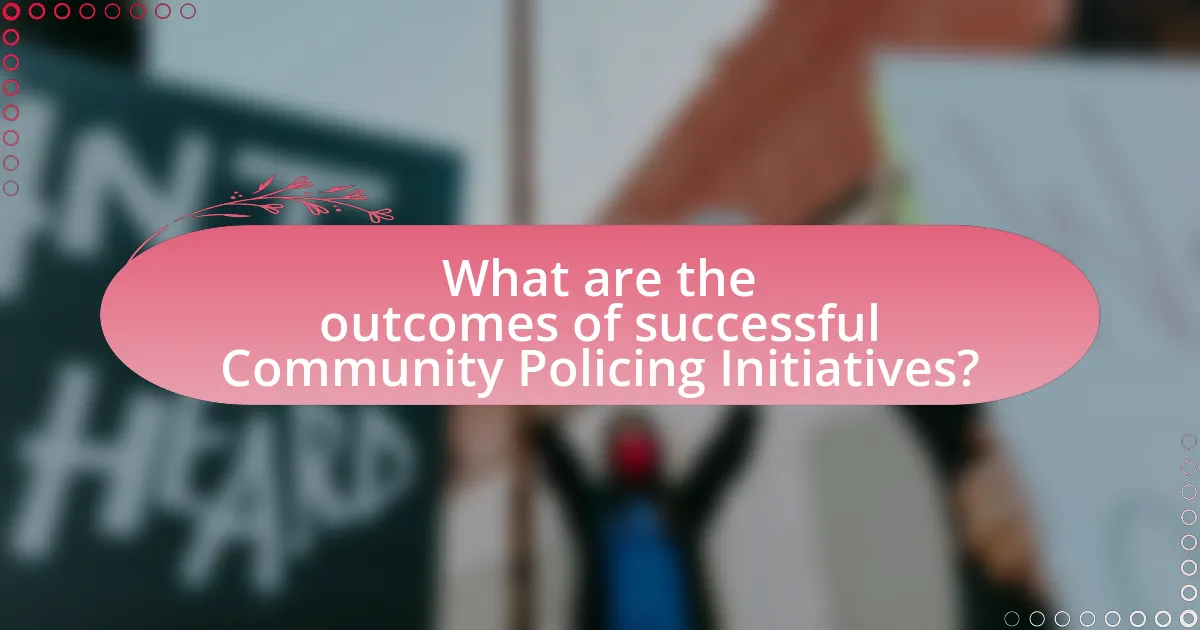
What are the outcomes of successful Community Policing Initiatives?
Successful Community Policing Initiatives lead to reduced crime rates, enhanced community trust, and improved police-community relations. For instance, a study by the Police Executive Research Forum found that neighborhoods engaged in community policing experienced a 20% decrease in violent crime over five years. Additionally, these initiatives foster collaboration between law enforcement and residents, resulting in increased reporting of crimes and community engagement in safety programs. This collaborative approach not only addresses crime but also builds a sense of ownership and responsibility among community members, further solidifying the relationship between residents and law enforcement.
How do these initiatives impact crime rates?
Community policing initiatives significantly reduce crime rates by fostering collaboration between law enforcement and local communities. These initiatives enhance trust, leading to increased reporting of crimes and proactive community engagement. For instance, a study by the National Institute of Justice found that cities implementing community policing strategies experienced a 20% decrease in violent crime over five years. This reduction is attributed to improved relationships that encourage community members to cooperate with police, share information, and participate in crime prevention efforts.
What evidence supports the effectiveness of Community Policing Initiatives?
Community policing initiatives have been shown to effectively reduce crime rates and improve community relations. Studies, such as the one conducted by the National Institute of Justice in 2015, found that areas implementing community policing strategies experienced a 20% decrease in violent crime over five years. Additionally, a meta-analysis published in the Journal of Experimental Criminology in 2014 indicated that community policing significantly enhances public perceptions of safety and trust in law enforcement. These findings demonstrate that community policing not only lowers crime but also fosters a collaborative relationship between residents and police, reinforcing its effectiveness.
How do successful initiatives improve community perceptions of law enforcement?
Successful initiatives improve community perceptions of law enforcement by fostering trust and collaboration between police and residents. Programs such as community policing, which involve officers engaging with community members through outreach and partnership activities, have been shown to enhance public confidence in law enforcement. For instance, a study by the Police Foundation found that neighborhoods with active community policing initiatives reported a 20% increase in residents’ trust in police. This improvement occurs as officers become more familiar with the community, leading to better communication and a shared commitment to public safety.
What best practices can enhance Community Policing Initiatives?
Best practices that can enhance Community Policing Initiatives include fostering strong relationships between law enforcement and community members, implementing regular community meetings, and utilizing crime data to address local concerns. Building trust is essential; studies show that when police engage with residents through outreach programs, crime rates decrease and community satisfaction increases. For instance, the U.S. Department of Justice highlights that initiatives like neighborhood watch programs and police-community partnerships lead to improved public safety outcomes. Additionally, training officers in cultural competency and conflict resolution can further strengthen these relationships, as evidenced by successful programs in cities like Chicago and Los Angeles, where community engagement has led to a notable reduction in tensions between police and residents.
How can ongoing training and development be integrated into these initiatives?
Ongoing training and development can be integrated into community policing initiatives by establishing continuous education programs that focus on communication, cultural competency, and conflict resolution. These programs ensure that law enforcement personnel are equipped with the latest skills and knowledge to effectively engage with diverse community members. For instance, the Police Executive Research Forum emphasizes the importance of training in de-escalation techniques, which has been shown to reduce the use of force in interactions with the public. Additionally, regular workshops and community feedback sessions can be implemented to adapt training content based on community needs and concerns, fostering a collaborative environment that enhances trust between residents and law enforcement.
What role does technology play in modern Community Policing Initiatives?
Technology plays a crucial role in modern Community Policing Initiatives by enhancing communication, data collection, and community engagement. Law enforcement agencies utilize tools such as social media platforms, mobile applications, and data analytics to foster transparency and build trust with residents. For instance, social media allows police departments to disseminate information quickly and receive feedback from the community, which can lead to improved public relations and collaboration. Additionally, data analytics helps identify crime patterns and community needs, enabling law enforcement to allocate resources more effectively. According to a study by the Police Executive Research Forum, 70% of police departments reported using technology to improve community engagement, demonstrating its significant impact on fostering trust between residents and law enforcement.
What practical steps can communities take to support Community Policing Initiatives?
Communities can support Community Policing Initiatives by actively engaging in collaborative efforts with law enforcement agencies. This includes organizing regular community meetings to discuss safety concerns, establishing neighborhood watch programs to foster vigilance, and creating partnerships with local organizations to address social issues that contribute to crime.
For instance, research from the U.S. Department of Justice indicates that community involvement in policing leads to a 20% reduction in crime rates in areas with active community policing programs. Additionally, communities can provide feedback to police departments through surveys and forums, ensuring that law enforcement practices align with community needs and expectations. By fostering open communication and mutual respect, communities can enhance trust and cooperation with law enforcement, ultimately leading to more effective policing outcomes.
